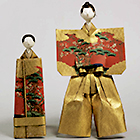Japanese Gallery (Honkan) Room 14
February 18, 2014 (Tue) - March 23, 2014 (Sun)
According to the old lunar calendar, the third day of the third month is the date of the peach blossom festival, or the girls' festival. Families traditionally celebrate this occasion by displaying hina dolls, which symbolize their prayers for the health and fortune of their daughters.
The origins of this tradition are unclear, but records reveal it became an annual event by the Edo period (1603-1868). The Edo Kanoko guidebook, written during the Jokyo era (1684-88), mentions hina doll markets being opened at several locations within Edo (present-day Tokyo), including Nakabashi, Owari-cho, Ningyo-cho, Jikkendana and Kojimachi.
During the first half of the Edo period, the most common type of hina doll was the standing type made of paper. After the mid-Edo period, seated dolls in costumes made of vibrantly colored fabrics sewn together gradually gained popularity. Variations included:
- Muromachi-bina, reflecting customs of the Muromachi period (1392-1573);
- Kyoho-bina, in exquisite costumes in layered brocade;
- Jirozaemon-bina, round-faced dolls popular in the Kansai region; and
- Kokin-bina, long-faced dolls favored in Edo.
Today, it is customary to display one set of Dairi-bina, a couple of hina dolls representing an emperor and an empress, accompanied by dolls representing three court ladies, two high-ranking ministers, court officials without rank, and a group of five musicians. In the late Edo period, by contrast, display styles were less restricted and full of vibrancy: multiple sets of Dairi-bina, several hina dolls, and dolls unique to local areas were displayed together.
This year, the exhibition also shows miniatures of court-noble costumes created by Edo-period craftsmen. Delicately crafted dolls and furnishings, as well as the miniatures of costumes, all reflect the Japanese people's characteristic love of miniature objects.

